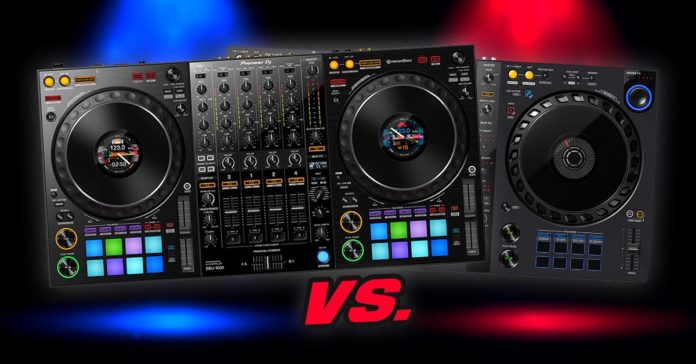Pioneer DDJ-1000 vs. DDJ-FLX6. Which one is better for you? Which one should you choose? In this comparison we will compare the DDJ-FLX6 and the DDJ-1000 in terms of features, build quality and their overall reliability. Let’s get straight into this detailed product comparison!
- Main differences
- The mixer sections
- Audio FX controls
- Performance pads
- Jog wheels comparison
- Merge FX & Jog Cutter on the DDJ-FLX6
- Inputs and outputs
- Software compatibility
- Pioneer DDJ-1000SRT – Serato compatible?
- Price and availability
- Pros and cons
- The conclusion – which one should you choose?
This web portal is reader-supported, and is a part of the Amazon Services LLC Associates Program and the eBay Partner Network. When you buy using links on our site, we may earn an affiliate commission!
Denon DJ SC Live 4 vs. Prime 4 (Direct Comparison!)
Main differences
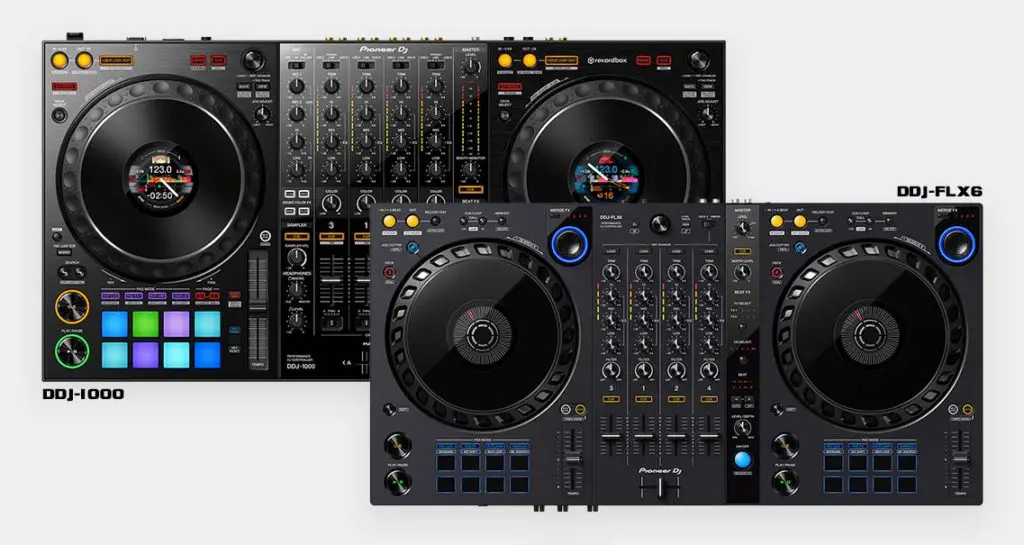
First things first, it’s important to say that the Pioneer DDJ-1000 is a full-fledged feature rich professional DJ controller that in use is comparable to an actual CDJ/DJM “club standard” setup.
The Pioneer DDJ-FLX6 on the other hand is a budget entry-level device, that while quite capable lacks many features that the DDJ-1000 has, and is geared mostly towards beginners.
Pioneer DDJ-FLX6 – DJ Controller Review.
In terms of size and weight, the DDJ-FLX6 is a little bit smaller than the DDJ-1000 but at the same time it’s much lighter. DDJ-FLX6 weighs around 8.38lb (3.8kg), and the DDJ-1000 weighs around 13.2lb (5.99kg).
While both these devices will cut it when it comes to letting you deliver a flawless live performance, the Pioneer DDJ-1000 is much more versatile and it gives you much more creative possibilities and advanced features than the very basic DDJ-FLX6.
Another thing is that the build quality of the Pioneer DDJ-1000 is on a much higher level, than the build quality of the DDJ-FLX6. The weight difference between the otherwise close in size devices and the price difference reflects that.
The mixer sections
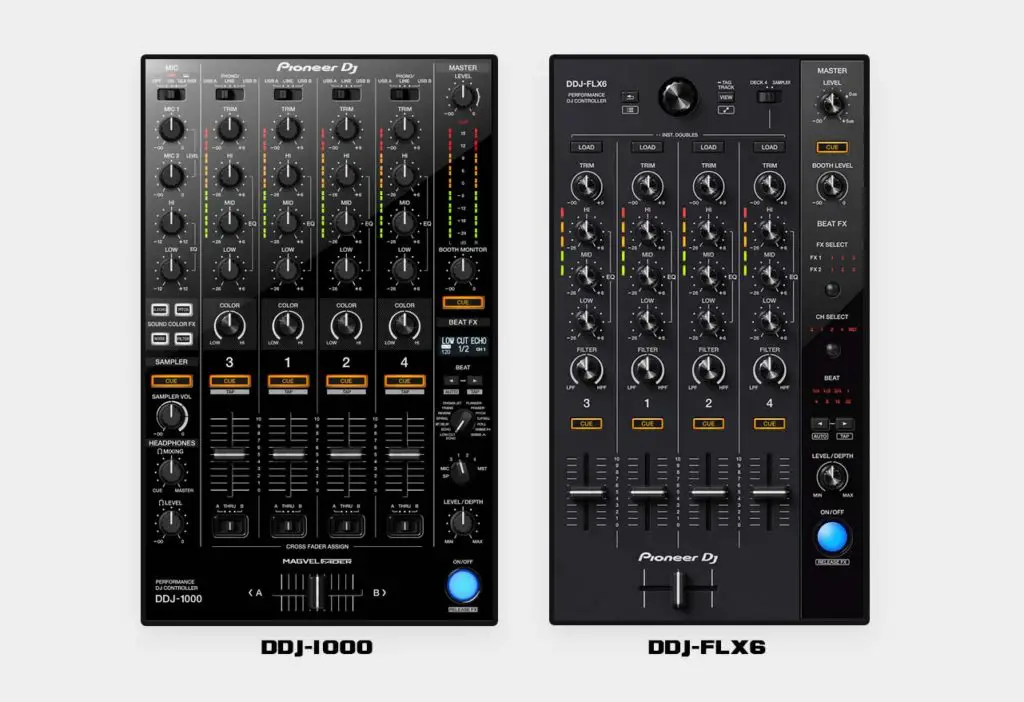
First important thing to mention here, is that while the mixer on the Pioneer DDJ-1000 can function as a standalone audio mixer, which means it features audio inputs for each of its audio channels, the mixer on the Pioneer DDJ-FLX6 is just a simple set of MIDI controls and cannot function in standalone mode.
The DDJ-1000 lets you use its mixer to control the DJ software of your choice, but also to connect additional, external third party audio devices and/or use the mixer section without your laptop plugged in (the decks will be inactive in standalone mode).
You can also use your Pioneer CDJ-2000/3000 players in HID mode together with the DDJ-1000 for extended 4 deck experience in the Rekordbox software.
While the Pioneer DDJ-1000 has two full size pitch faders, the Pioneer DDJ-FLX6 only features the half-sized versions of the regular pitch controls typical for smaller entry-level DJ controllers.
Numark NS4FX vs. Pioneer DDJ-FLX6 (Which One Is Better For You?)
The mixer section of the Pioneer DDJ-1000 is much more feature packed than the one on the DDJ-FLX6. It features Beat FX and Sound Color FX strips, full size channel & master VU meters and channel input/assignment switches.
As the DDJ-1000 doesn’t have its track selection buttons and knob in the top of the mixer section, it features separate track loading/library search controls for each deck.
The mixer on the Pioneer DDJ-FLX6 doesn’t have full-size mixer channel VU meters, it also does not feature Sound Color FX controls as these are not supported by the device.
Audio FX controls
In terms of audio FX controls the most important thing is: The Pioneer DDJ-1000 has an independent FX section that can work when you’re using its mixer in standalone mode. All of the audio effects are processed by the hardware, so locally on the controller. Of course you could also resort to using software FX if you wish to do so.
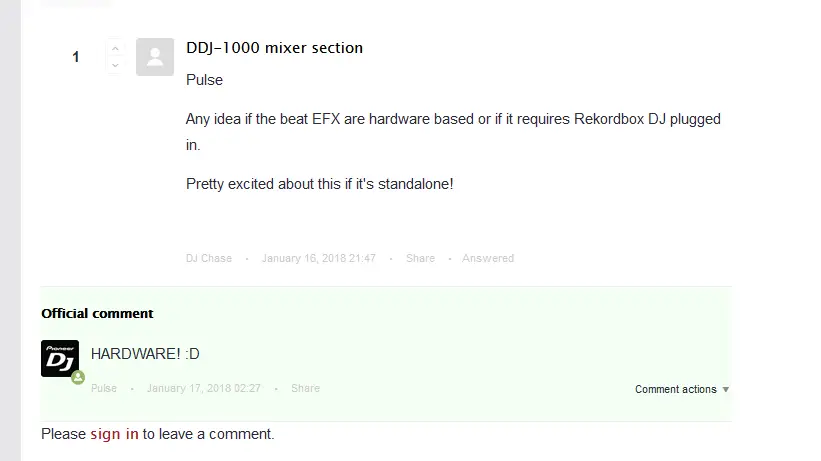
Because Pioneer DDJ-FLX6 doesn’t have a mixer that is able to take additional audio channel inputs or work in standalone mode at all, it also doesn’t have any on-board effect processor. All the FX control buttons that are present on this device simply control the FX of the DJ software you’re using.
On the DDJ-FLX6 there are 3 distinct ways to use audio FX. The first one is using the built in scaled down version of the Pioneer Beat FX strip on the right side of the mixer. You can find our elaboration on the DDJ-FLX6’s audio FX controls here. Long story short, it’s not the best set of FX controls we’ve seen to say the least.
The second way is to use the Pad FX mode accessible from the controller’s performance pads. This way you can use a bank of fully customizable press-and-hold audio FX activated momentarily with a press of a button.
The last, final way to use audio FX on the Pioneer DDJ-FLX6 is to use the Merge FX knob present on each deck (that we cover in more detail here). Merge FX is a set of 4 combo FX presets meant for assisting your track transitions, mainly these where large tempo differences are involved.
Pioneer DDJ-1000 also lets you use audio FX in 3 different ways. The first one is the now full-size Beat FX strip taken straight from the Pioneer DJM-900NXS2 professional standalone DJ mixer. There are 14 high quality Beat FX to choose from, all processed by the DDJ-1000’s hardware.
Your second wave of utilizing audio FX on the DDJ-1000 is using the Sound Color FX strip on the left side of your mixer. Here you have access to 4 Sound Color FX (echo, pitch, noise an filter). You control there using the Sound Color FX strip and the filter knob on each of the mixer channels. You can use the Sound Color FX strip and the Beat FX strip independently which means you can have two effects active at the same time (plus your software effects activated using the Pad FX mode).
The last way is the said Pad FX mode which works identical on the DDJ-1000 as it did on the DDJ-FLX6. The only difference is, that on the Pioneer DDJ-1000 you are given access to two 8 slot Pad FX banks instead of one.
Overall, the Pioneer DDJ-1000 does a much better job on handling the audio FX and it’s much more versatile in terms of the variety of available effects.
Performance pads
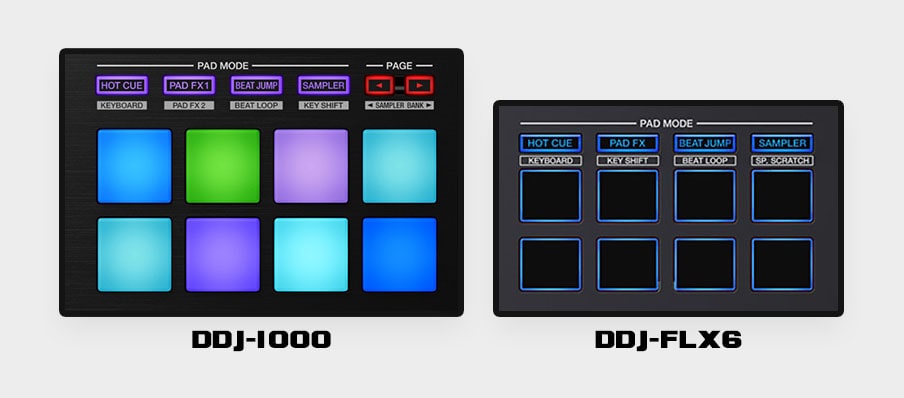
Performance pads on the Pioneer DDJ-1000 are the standard “full-size” performance pads that you can find on many other professional Pioneer DJ devices such as the Pioneer DDJ-SX3. Pads on the DDJ-1000 also feature RGB backlight.
The pads on the Pioneer DDJ-FLX6 are much smaller than the ones on the DDJ-1000, and in terms of backlight they can offer only blue backlit edges.
Both DDJ-1000 and DDJ-FLX6 let you access 8 different performance pad modes, but the DDJ-1000 has additional pad mode page select button that allows you to access additional sampler banks and additional pages in some of the pad modes (depending on the software you’re using).
In terms of exact performance pad modes, these two devices are roughly the same, other than the Pioneer DDJ-1000 features 2 Pad FX banks, and the Pioneer DDJ-FLX6 has the Sample Scratch pad mode which the DDJ-1000 doesn’t have.
The Sample Scratch mode on the Pioneer DDJ-FLX6 allows you to quickly load scratch samples onto a deck, much like the Serato Scrach Bank feature on some of the other Serato DJ compatible controllers.
Overall, the performance pads on the DDJ-FLX6 feel pretty much the same as pads on any other entry-level DJ controller, it’s not a surprise in this price range. The DDJ-1000 is the way to go if you’re set on getting a controller with the most comfortable and efficient performance pad controls.
Jog wheels comparison
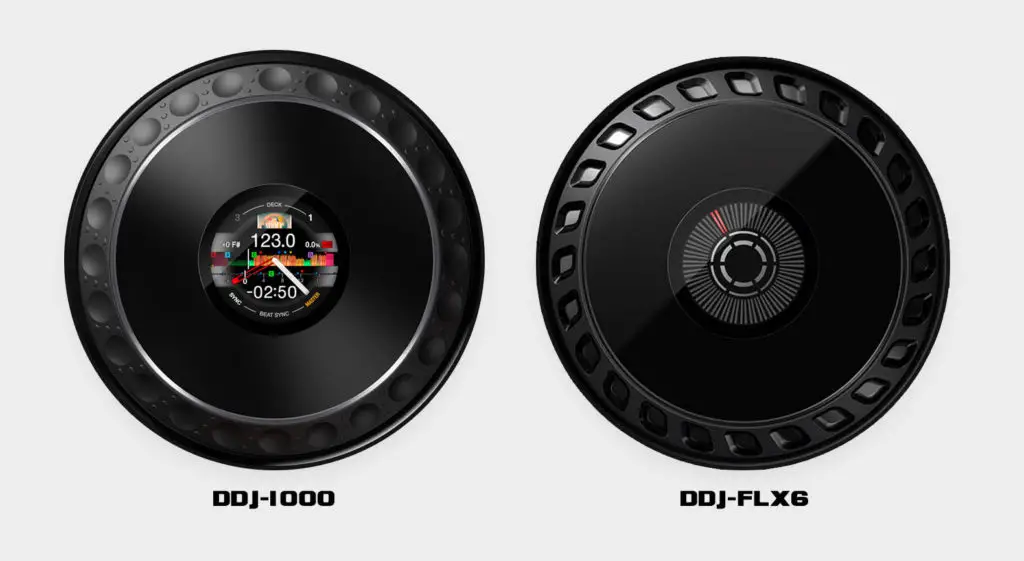
One of the most important differences between the Pioneer DDJ-1000 and the Pioneer DDJ-FLX6 is the difference in the jog wheel type.
The Pioneer DDJ-1000 has 2 full-size mechanical jog wheels on board, the very same ones you can find on the Pioneer CDJ-2000NXS players. The jog wheels on the DDJ-1000 are roughly 8.11 in / 206 mm in diameter. They are pretty much the highest quality mechanical jog wheels you can get on a Pioneer DJ controller as of now.
DDJ-1000 also features nifty built-in jog wheel displays that can display your track details and album art. It’s a neat little feature that is nowadays more and more present on DJ controllers (sometimes even on cheaper entry-level devices such as the Numark Mixtrack Platinum FX).
Numark Mixtrack Platinum FX vs. Pro FX (Which Is better?)
Pioneer DDJ-FLX6 features 2 capacitive jog wheels that are roughly the same size that the ones on the DDJ-1000. The pattern used in the design of these platters is a new one that Pioneer hasn’t used in any other device.
The jog wheels on the DDJ-FLX6 feel somewhat cheaper than the ones on the DDJ-1000 but in our experience they are still pretty pleasant to use for beatmatching.
The simple LED needle indicators on each of the DDJ-FLX6’s jog wheels tell you the current position of the virtual needle on your deck. When it comes to the DDJ-FLX6, there are no built in displays on the jog wheels.
The main difference between mechanical and capacitive jog wheels is that the mechanical jog wheel uses the pressure of your touch to determine whether or not your hand is touching the wheel’s surface, while a capacitive jog wheel has a touch-sensitive capacitive surface that deals with that matter.
Choosing one jog wheel type over the other is purely a matter of preference.
Merge FX & Jog Cutter on the DDJ-FLX6
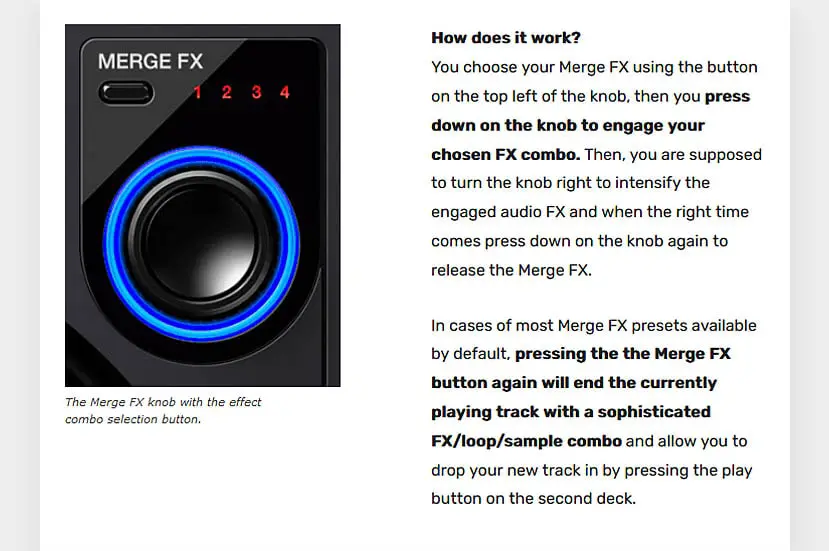
The Pioneer DDJ-FLX6 may not have all the features the DDJ-1000 has, but it has two distinct features aimed at beginners that are unique to it and not seen on any other Pioneer DJ controllers. These features are the Merge FX knobs and the Jog Cutter mode.
The Merge FX knob is essentially a shortcut for 4 combo transition FX presets, and the Jog Cutter mode is a way of automating scratching without the use of a crossfader. You can learn more about these features in our review of the Pioneer DDJ-FLX6 here.
Inputs and outputs
When it comes to the Pioneer DDJ-FLX6, it features a simple master RCA output and RCA booth output. Sadly there are no XLR outputs here, although again this is to be expected from an entry-level DJ controller.
An important thing to note here, is that the booth output on the DDJ-FLX6 is an RCA output. This is different from the standard 1/4 inch jack booth outputs you can find on most DJ devices.
In terms of headphone outputs on the DDJ-FLX6 there are two of these – 1/4 inch jack and a 1/8 inch jack. There is also a 1/4 inch jack mic input on the back of the device, with a small mic gain knob next to it.
On the Pioneer DDJ-1000 aside from the audio inputs for each mixer channel, you have the XLR and RCA outputs and mic inputs (both jack and XLR). There are also 1/4 inch jack booth outputs here alongside with two jack headphone outputs.
The DDJ-1000 has 2 USB inputs for back-to-back mixes, the DDJ-FLX6 doesn’t give you that option.
While the Pioneer DDJ-FLX6 is USB bus powered, the Pioneer DDJ-1000 requires a power supply to be connected to use it.
In terms of audio inputs and outputs the DDJ-1000 is much more versatile.
Software compatibility
Pioneer DDJ-1000 is a dedicated Rekordbox DJ controller, but it will also work with Virtual DJ (provided you purchase an appropriate Virtual DJ license). It can also work under Traktor DJ software if you’re able to find appropriate MIDI map files or are able to make a MIDI mapping for it yourself.
Although you cannot use the Pioneer DDJ-1000 with Serato DJ, there is another version of this controller that is specifically made to be compatible with Serato DJ software – the Pioneer DDJ-1000SRT.
The Pioneer DDJ-FLX6 is primarily a Rekordbox DJ controller. Although you can also use it with Serato DJ, is not primarily a Serato DJ controller, it will have much better integration with Rekordbox software, including better handling of Merge FX and Pad FX features.
You can also use your DDJ-FLX6 with Virtual DJ (again with an appropriate license purchased) or with Traktor (with an appropriate MIDI mapping).
If you’re wondering about the differences between Serato DJ Lite and Pro, check out our detailed Serato DJ Lite software review.
Pioneer DDJ-1000SRT – Serato compatible?
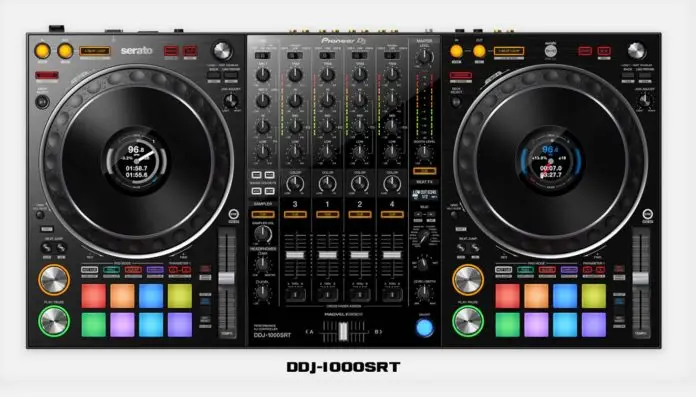
Although the DDJ-1000 is a dedicated Rekordbox DJ controller and it can’t be used alongside Serato DJ software, there exists the Pioneer DDJ-1000SRT that is actually fully compatible with Serato DJ.
There are some minor differences between the DDJ-1000 and the DDJ-1000SRT, for example in the way the performance pad modes function, or what is displayed on the jog wheels during operation, but in terms of features these controllers are largely the same.
Price and availability
With the ongoing electronic component shortage and the huge popularity of the Pioneer DDJ-1000 you might find yourself refreshing the DDJ-1000 product page on Amazon in hopes of it suddenly appearing as available in the official Pioneer DJ store.
There is a better method however. Check the supply of your local music stores (or the ones a bit farther from your location) and ask if they have the DDJ-1000 in stock. Oftentimes local businesses ans stores can still have some units on hand, and you will be able to get your Pioneer DDJ-1000 right away.
In terms of the DDJ-FLX6, the situation regarding supply seems to be a little bit better, as the FLX6 is in general always available in the official Pioneer DJ store on Amazon.
It’s often the case with the more affordable DJ controllers such as the DDJ-400 or the DDJ-800, that they are produced in larger quantities than the more professional audio gear which gets purchased somewhat less often.
You can check both the price and availability of the Pioneer DDJ-1000 and the Pioneer DDJ-FLX6 in the official Pioneer DJ store on Amazon using the links down below.
Just keep in mind that regardless of price fluctuations, the Pioneer DDJ-1000 will always be much more pricey than the DDJ-FLX6 that is still considered and meant to be an affordable entry-level budget device.
| Controller | Features | Price |
|---|---|---|
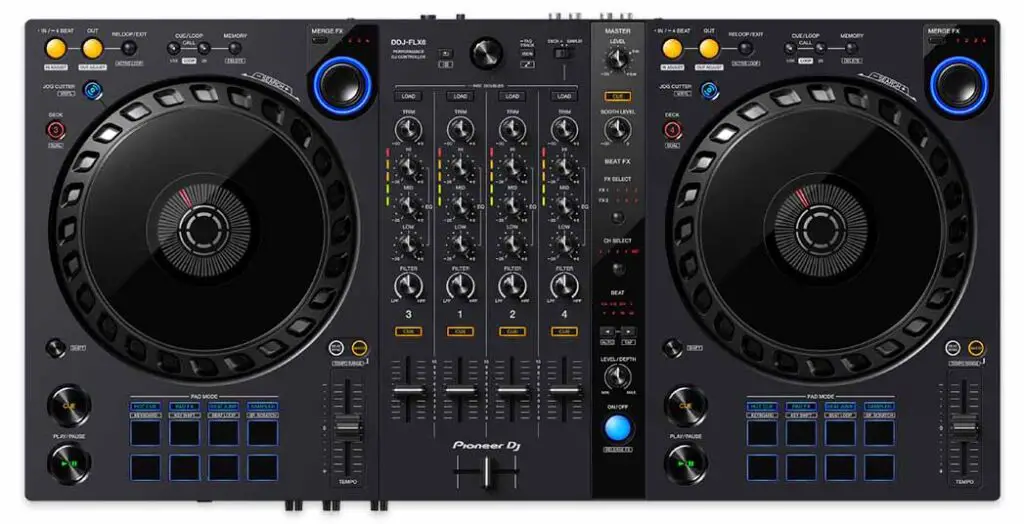 | Pioneer DDJ-FLX6: – 4 channels on an entry-level device. – Full-size 8″ jog wheels. – Reasonably priced option. | Check price on Amazon Check price on Ebay |
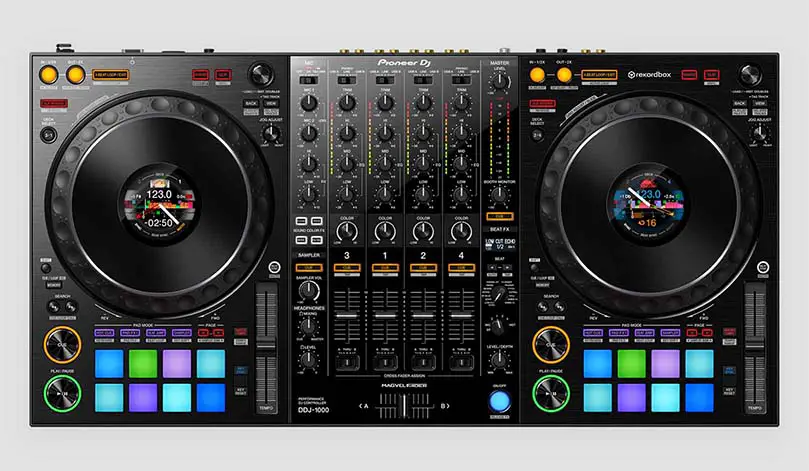 | Pioneer DDJ-1000: – High quality mechanical jog wheels. – Outstanding audio FX selection on-board. – One of the best professional DJ controllers on the market right now. | Check price on Amazon Check price on Ebay |
Pros and cons
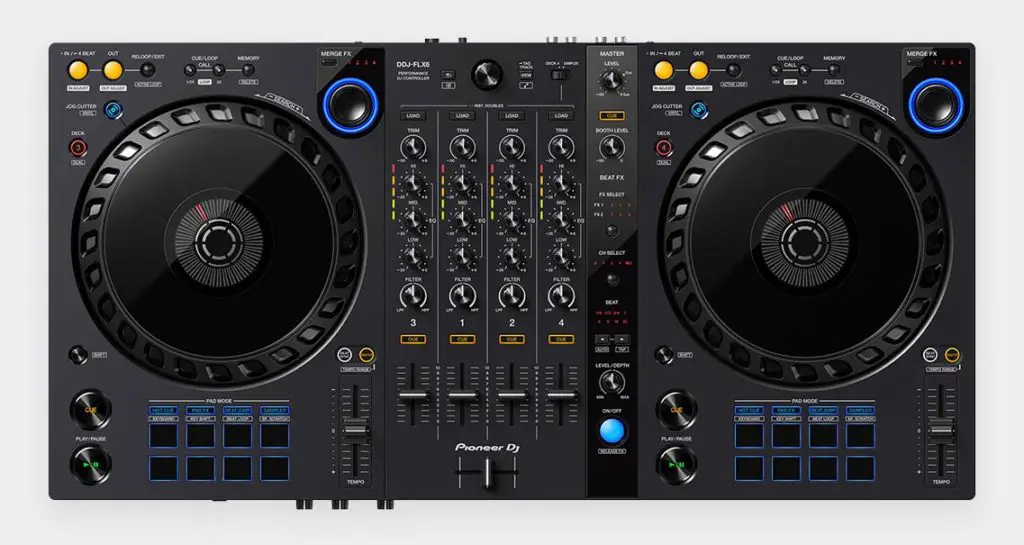
Pros:
- Great and affordable entry-level DJ controller.
- Full size 8 inch capacitive jog wheels.
- Pretty cheap for a device with 4 mixer channels.
Cons:
- Features just a simple RCA out (no XLR cable outputs).
- Worse build quality compared to the DDJ-1000.
- No additional audio in besides the single microphone input.
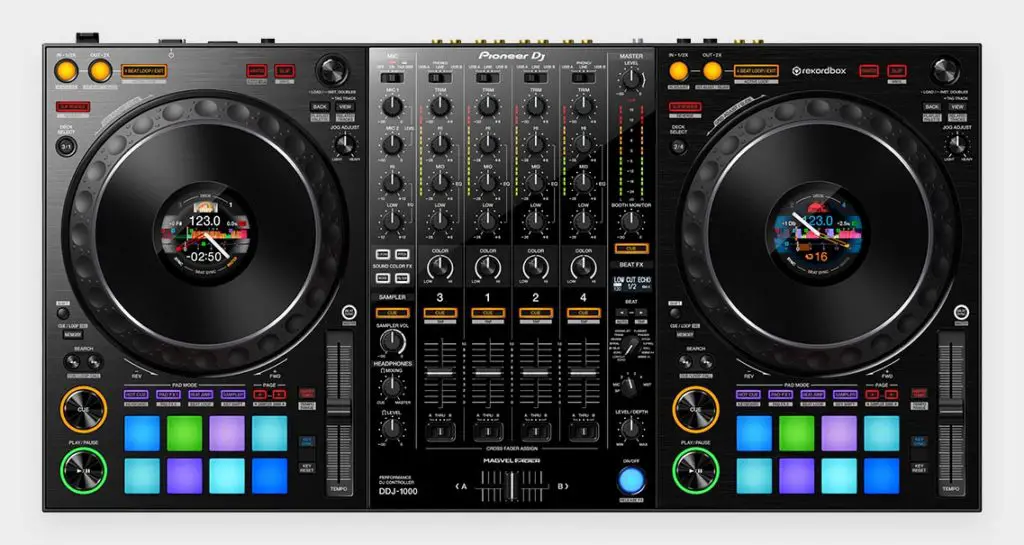
Pros:
- Full size mechanical jog wheels straight from the Pioneer CDJ-2000 players.
- A full set of Pioneer Pioneer DJM-900NXS effects.
- Comes both in Rekordbox and Serato compatible variants.
- Using it feels much like actually using a full CDJ/DJM “club standard” setup.
Cons:
- Much more pricey than the DDJ-FLX6.
- Features just a simplified version of the Sound Color FX section.
The conclusion – which one should you choose?
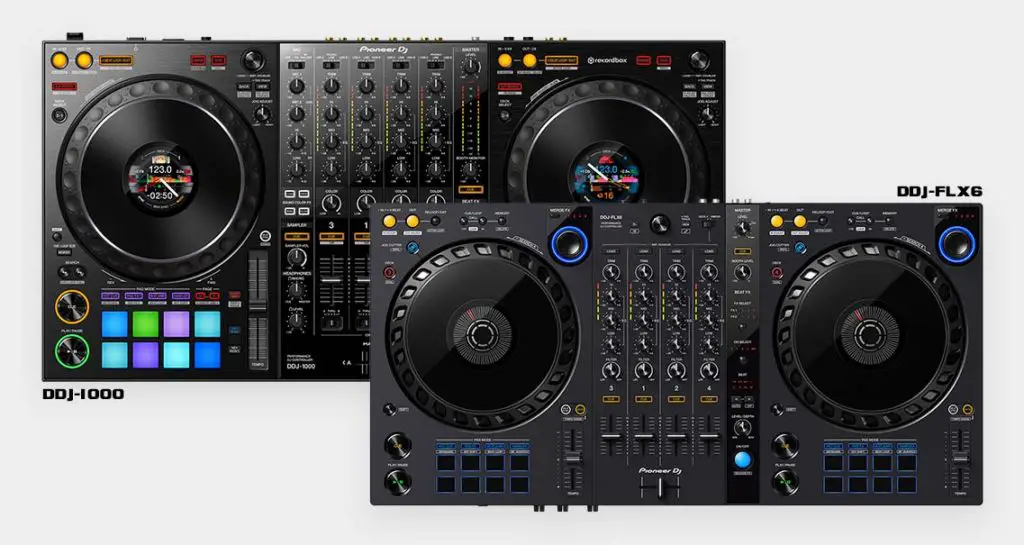
Remember, that the Pioneer DDJ-1000 is correctly labeled as a professional high-end DJ controller and its capabilities are close to a full fledged club player setup. The DDJ-FLX6 still is simply an entry-level DJ device that cannot really be compared in a fair match to the DDJ-1000.
The Pioneer DDJ-FLX6 lies somewhere on the middle ground between the DDJ-400 and the DDJ-1000 both in terms of features and in terms of price. While being a great entry-level device, it might not satisfy more ambitious users that simply want all the good stuff and features available right away.
Numark NS4FX vs. Pioneer DDJ-FLX6 (Which One Is Better For You?)
If only you have the money, you should go for the Pioneer DDJ-1000 and you definitely won’t regret it. Otherwise, consider taking a look at DJ controllers such as Pioneer DDJ-800 or Numark NS4FX as alternatives to the Pioneer DDJ-FLX6. They might be a better solution for you then. Rock on!
| Pioneer DDJ-FLX6 on Ebay: |
| Pioneer DDJ-1000 on Ebay: |

